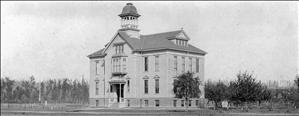This history of Concord School is taken from the second edition of Building for Learning: Seattle Public School Histories, which includes histories of every school building used by the district since its formation around 1862. The original essay was written for the 2002 first edition by Nile Thompson and Carolyn J. Marr, and updated for the 2024 edition by HistoryLink contributor Ryan Anthony Donaldson.
South Park
The first school in the South Park neighborhood was called South Park School. It was opened in 1902 or earlier and became part of the Seattle School District in 1907. The school sat at the bottom of a hill. A slough immediately adjacent to the school proved to be an irresistible temptation for adventurous boys on their way to school. Many explored it on tippy rafts and had to explain why they were tardy and dripping wet.
In 1909, the school board purchased another site in the South Park neighborhood, on Concord Street between Seventh and Eighth Avenues S. Three years later, the board voted to build a new fireproof brick school there to relieve overcrowding at South Park School. The new school was named Concord School since it faced Concord Street and sat atop a hill. The Concord building was in the Colonial Revival style, identical to McGilvra and McDonald. On January 25, 1914, some 200-300 of the students at South Park cleared out their desks and, with books and supplies in hand, began the long march to their new school. As they neared their destination, they heard the first streetcar crossing the new bridge across the Duwamish River on Eighth Avenue S.
The first recess at the new school was messy, for the school ground was a morass of sticky mud. Pupils who played in it soon were un- recognizable and sent home to clean up. Those who ventured off the grounds found they were easily lost in the unfamiliar surroundings of ferns and hazelnut bushes that covered the hillside. The principal, F. C. Jackson, who had been at South Park School, quickly established new rules and regulations.
Concord was transformed from a grade 1-8 school to a K-6 school in 1927-1928 with the opening of the combined junior and senior high school at Cleveland. The 7th grade returned for just the 1931-1932 year. In September 1932, students from the annex were placed at Concord and South Park was closed. Enrollment peaked in 1958-1959 with 516 students. By 1960, six portables stood on the Concord grounds. A gymnasium and multipurpose room were added in 1971, and the number of portables was reduced to three.
Surprise Discovery
In 1990, a surprise discovery was made when a chalkboard was being removed to install bulletin boards. Beneath the chalkboard was an older blackboard that had been decorated by a 6th grade class in June 1938. Three colored-chalk drawings depicted scenes from Norway, Portugal, and Italy. The six artists signed under the pictures, while the other 20 members of the graduating class signed in lists between the chalk drawings. The discovery led to a reunion event with teacher Mary Luch Bleakney and some of the students from the 1938 class.
As part of their world cultures program, students built a model Mayan village, learning math, agriculture, government, and fine arts in the process. Concord became an ESL/Bilingual Center in 1996-1997 with around 17 percent of students receiving bilingual services. In fall 1997, Concord became a model school for the Different Ways of Knowing Program that combines social studies and the arts. Its Attic Theater Program brought all students into integrated drama, dance, and cultural studies.
During the 1999-2000 school year, the Concord building was renovated and a classroom addition was constructed (designed by Tsang Partnership). With the school closed for construction, students went to E. C. Hughes as an interim site. In September 2000, students returned to the improved school on the enlarged 4.21-acre site after spending a year at Hughes. The district purchased the remaining few houses located on the block, allowing Seattle Public Schools to own the entire block that Concord occupies. In 2009, Concord expanded school programming to include an International School with two-way dual language immersion in Spanish and English, becoming Seattle’s third school to offer this program. In 2014, enrollment hit a peak at 412 students. The bilingual program grew, with 49 percent of the students receiving bilingual services.
History
South Park
Location: 12th S between Sullivan & Thistle
Building: 8-room, 2-story wood
Architect: n.a.
Site: 0.85 acres
ca 1902: Opened
1907: Annexed into Seattle School District
1914 -32: Operated as an annex of Concord
1932: Closed
1938: Building demolished
n.a.: Site sold, given or traded to parks board
Present: Site of South Park Community Center (8319 8th Avenue S)
Concord School
Location: 723 S Concord Street
Building: 9-room, 3-story brick
Architect: Edgar Blair
Site: 1.43 acres
1913: Named on February 24
1915: Opened on January 25
1928: Site expanded to 1.93 acres
1945: Site expanded to 3.44 acres
1971: Addition (Shavey & Schmidt)
1998: 1913 exterior and first floor entrance stairwell designated City of Seattle landmark on February 18
1999: Closed for construction; Site expanded to 4.21 acres; Students relocated to E. C. Hughes as an interim location
2000: Addition and renovated school reopened
2009: International School program introduced
Concord International Elementary in 2023
Enrollment: 329
Address: 723 S Concord Street
Nickname: none
Configuration: K -5
Colors: Green and white

